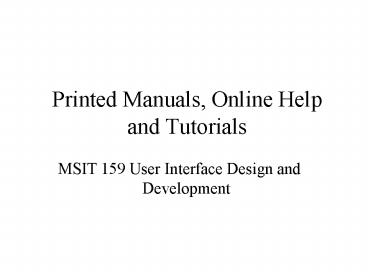Printed Manuals, Online Help and Tutorials - PowerPoint PPT Presentation
1 / 22
Title:
Printed Manuals, Online Help and Tutorials
Description:
Draw transition diagrams. Use advance organizers and summaries ... Splitting display among work, help, and tutorials leaves less useful screen space ... – PowerPoint PPT presentation
Number of Views:89
Avg rating:3.0/5.0
Title: Printed Manuals, Online Help and Tutorials
1
Printed Manuals, Online Help and Tutorials
MSIT 159 User Interface Design and Development
2
System Delivery
- Usually Involves
- Training
- Documentation
- Likely User Audience
- Users
- Operators
3
Printed Documentation Types
- Alphabetic command lists
- Quick reference cards
- Brief getting started notes
- Novice user tutorials
- Conversion manuals
- Detailed reference manuals
4
Online Documentation
- Man pages
- Help facility
- Tutorials
- Demonstration
5
Problems with Most Computer Documentation
- Simply present operator descriptions
- Organized according to system functions, not user
goals - Too voluminous for novice users
- Rarely presents complete methods explicitly
- Talks about how system works, not how it can be
used - User must problem solve even simple tasks
- Rarely presents selection rules
6
Why is reading from computer displays more
difficult than reading from paper?
- Poor fonts
- Low contrast between characters and backgrounds
- Emitted light rather than reflected
- Small displays require frequent page turning
- Display placement too high
- Layout and formatting problems
- Reduced body motion make them more fatiguing
- Displays less familiar than books
7
Printed Manual Guidelines
- Let user's task guide organization
- Let user learning process shape sequencing
- Present semantics before syntax
- Keep writing style clean and simple
- Show numerous examples
- Offer meaningful and complete sample sessions
- Draw transition diagrams
- Use advance organizers and summaries
- Provide table of contents, indices, and
glossaries - Include list of error messages
- Give credit to all project participants
8
Process of Developing Print Manuals
- Use professional writers and copy editors
- Prepare user manuals before implementation
- Review drafts thoroughly
- Field test early drafts
- Provide feedback mechanism to readers
- Revise to reflect changes regularly
9
User Documentation Life Cycle
- Develop specifications
- Prototype
- Draft
- Edit
- Review
- Field test
- Publish
- Perform post project review
- Maintain
10
- GOMS models provide good starting points for
writing documentation.
11
Guidelines for Using Goals to Organize Task
Oriented Documentation
- Use high level goals as a table of contents
- List high level goals in natural task sequence
- High-frequency goals and critical sub goals
should be documented fully - Each user goal should have a complete and
executable method - Judgement calls must be used regarding prior user
knowledge of methods and operators - Methods should be checked for correctness
12
Limitations of GOMS for Documentation
- Only specifies content and organization of
procedural knowledge - Does not address readability, pedagogy, layout,
typography, content, graphics use, etc.
13
Advantages of Online Manuals
- Information is available when computer is
available - User dont need space to open printed manuals
- Manual updates are low cost
- Electronic indexing allow fast search of manual
- Multimedia help may be beneficial
14
Disadvantages of Online Manuals
- Displays may not be as easy to read as print
manuals - Each screen contains less info than 1 printed
page - Interface operations may confuse novices
- Splitting display among work, help, and tutorials
leaves less useful screen space - Additional burden on user
15
Online Facilities
- Successively more detailed error explanations
- Instruction on system use
- Examples of correct commands
- Descriptions of current system parameters
- Lists of commands
- News for system users
- List of available user aids
16
Guidelines for Preparing Online Help (Kearsley)
- Make help system easy to access and return from
- Make help as specific as possible
- Collect user data to determine what help is
needed - Give users control over the level of help
provided - Supply different types of help for different
types of users - Make help message complete and accurate
- Do not use help to compensate for poor user
interface design
17
Online Implementation
- Word processing documents
- Hypertext
- Unix man pages
- Help menu
- Key words to organize menu driven help
- Context sensitive help
- Balloon help
18
Tutorials Guidelines for Developing
Lessons(Steinberg)
- Initial planning - lesson level
- Ripple plans - unit level
- Complete the lesson - lesson level
19
Writing the Presentation
- Generate unit goals
- Choose teaching technique based on cognitive goal
for lesson (recall, comprehension, application,
analysis, synthesis, evaluation) - Write script
- Generate questions and exercises
20
Checking Lesson for Effectiveness
- Pretest and posttest
- Questionnaires
- Student interviews
- Field trials
- Expert review
21
Lesson Review - Pass One
- Check identification information
- Content review
- Check boundary conditions
- Examine instructional technique (tutorial, drill,
problem solving, game, simulation) - Technical review
- Supplementary equipment required
- Overall reactions
22
Lesson Review - Pass Two
- Content
- Instructional technique (presentation, questions,
responses, feedback, remediation) - Lesson management
- Human factors
- Displays































